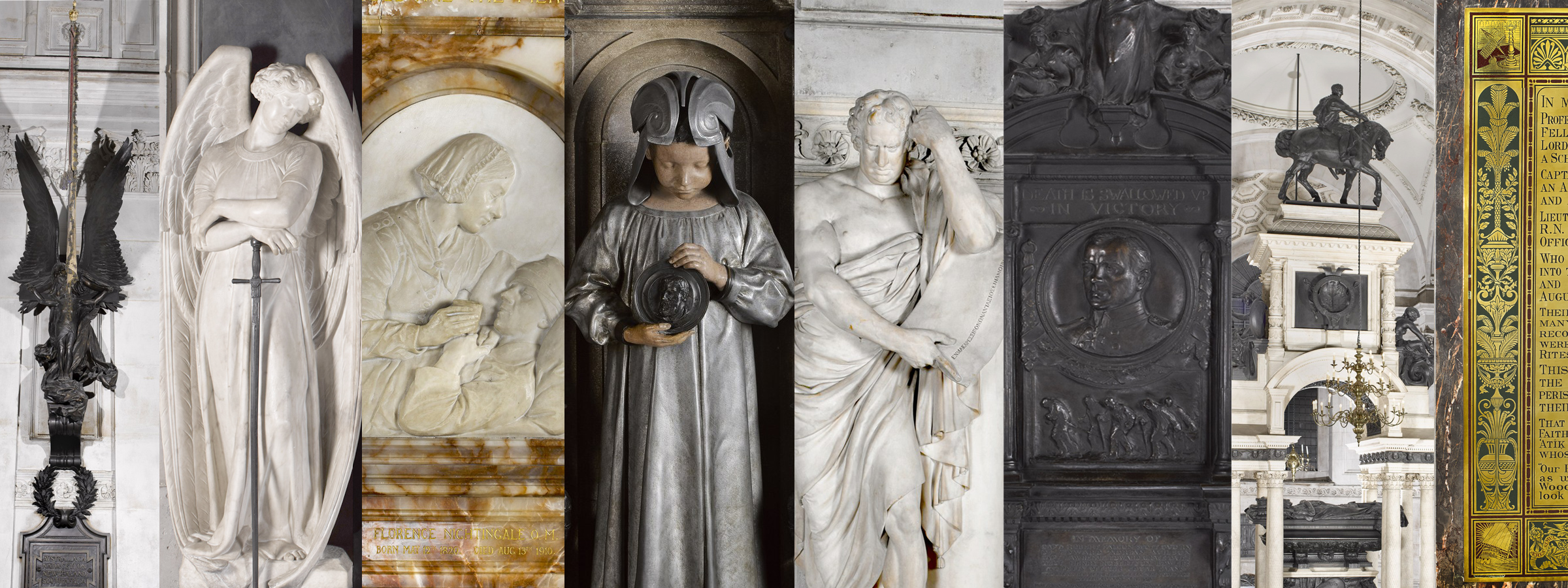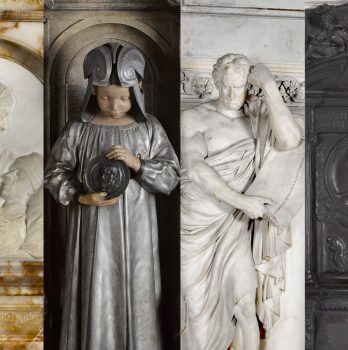Theologian and Author Paula Gooder’s Response to the Monument to William Viscount Melbourne (1779-1848) and Frederick, Viscount Melbourne (1782-1853) by Carlo Marochetti RA, 1853


Transcript
By Dr Paula Gooder
I remember the first time that I ever visited St Paul’s being intrigued by a door halfway down the north aisle, on the left hand side of the nave. The door is black and flanked by too angels both carrying swords. Above the door are the words ‘Through the gate of death we pass to our joyful resurrection.’ I am now the Canon Chancellor of the Cathedral and I pass the door on an almost daily basis, and it intrigues me no less than the first time I saw it.
The issue is that it looks like a door. Its message is all about passing through a door to resurrection, but the door doesn’t open. It can’t open. It never will open. It’s a sculpture, a memorial, which sits firmly closed on an impenetrable wall.
When the memorial was first installed, the Dean of the time, the Very Reverend Henry Hart Millman, welcomed it with enthusiasm. When memorials were first introduced into Wren’s Cathedral in the late 18th century, they largely depicted people, those being remembered. This memorial to two Melbourne brothers, William Lamb Melbourne a former Prime Minister and his brother Frederick who was a diplomat, was the first to have an overtly religious theme and Dean Millman loved it.
What I wonder, though, every time I pass by, is what the memorial really says. Not only does the door not open, but the angels appear to be sleeping. The implication is that wearied as they are by their years of waiting for the door of death to open to a new life of resurrection, they have dropped off to sleep.
The clue to the message of the memorial maybe found in the origin of the quote above the door. The words, ‘Through the gate of death we pass to our joyful resurrection’ comes from the prayer set for Easter Eve – the day before Easter. On Easter Eve we wait for the joy of Jesus’ resurrection to arrive but of course, Christian’s believe, that even as we celebrate Easter we are still waiting. We are waiting for that moment in the future when there will be no more death or dying, when God will wipe away all tears from our eyes. In that future for which we wait, the dead will rise, and the door of death will swing open to a new resurrection world of peace, and harmony and justice. Waiting for that time is wearisome, and at times like this, hard to bear but it is worth waiting for. The door may be closed now, but one day it will open. The angels may sleep now, but one day they will awake.
Marochetti’s curious non-opening door is worth pausing with and reflecting on… the answers it hints at are packed full of hope.
About Paula Gooder
Dr Paula Gooder is the Chancellor of St Paul’s Cathedral in London. She is a New Testament scholar and has taught widely throughout her career. She is the author of a number of books. The most recent include Women of Holy Week (2022); Journalling the Psalms (2022); The Parables (2020) and Phoebe: A Story (2018).
Visit Paula Gooder’s website and find her on Twitter and Facebook.
About the Monument
Brothers William (1779–148) and Frederick Lamb (1782–1853), the 2nd and 3rd Viscounts Melbourne, were both figures at the heart of British public life.
William was twice Prime Minister. In fact, he was the last prime minister to be dismissed by a monarch – William IV – though he was later to be reinstated by Queen Victoria. William’s wife, Lady Caroline Lamb (1785–1828) was the author of the Gothic novel Glenarvon, who gained notoriety following her affair with Byron.
Frederick was a diplomat, who served as British ambassador in Portugal and Austria.
The brothers’ 1853 memorial by Carlo Marochetti RA (1805–1867) was, as Paula Gooder points out, the first overtly theologically themed monument in St Paul’s Cathedral and was very positively received by the then Dean of the cathedral, Henry Hart Milman. Marochetti returned to the theme of sentinel angels with full-height wings for the Crimean War memorial known as the ‘Scutari’ monument (1856, Istanbul) and the Cawnpore Memorial (c. 1865, Kanpur).


